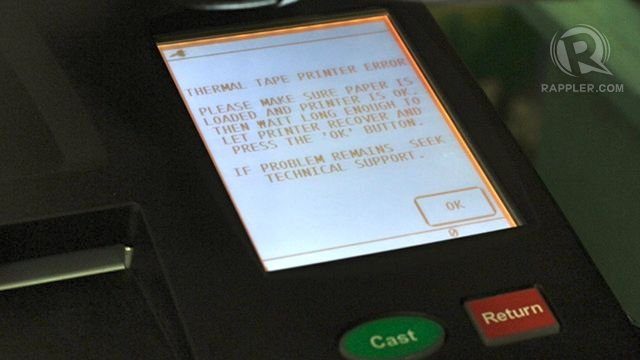SUMMARY
This is AI generated summarization, which may have errors. For context, always refer to the full article.

MANILA, Philippines – More than 81,000 voting machines that were used by the Commission on Elections (Comelec) for the 2010 and 2013 polls are gathering dust in its warehouse in the province of Laguna, as efforts to dispose of them failed to attract buyers.
That’s nearly two years since the Comelec posted on its website a notice for the auction of the precinct count optical scan (PCOS) machines, with a minimum bid price of P187.5 million. The PCOS machines were the predecessor of the vote-counting machines (VCMs) that have been in use since 2016.
“We attempted to dispose the same through the usual disposal process in accordance with the Commission on Audit rules. Nobody would like to procure or secure a piece of the PCOS machines,” Chairman George Garcia said on Monday, March 27, in a speech during a forum mounted by pro-democracy coalition PARTICIPATE.
As early as 2014, the poll body considered selling the retired machines, which Comelec procured at P9 billion.
“We have a wide range of experience and expertise in terms of automated elections. This is why if we become vendors, it is highly unlikely that there will be no takers,” then-spokesman James Jimenez said at the time.
The machines were first used in 2010, after the Comelec entered into a lease-with-option-to-purchase (LWOP) agreement with winning bidder Smartmatic. The commission paid P7.2 billion that year, and another P1.8 billion in 2013 to own the machines.
But in 2015, the Supreme Court prohibited the Comelec from refurbishing the PCOS machines, rendering them useless and forcing the poll body to conduct a public bidding for new machines in 2016.
Same, old dilemma
Now, Garcia is insistent on retiring the 97,000 vote-counting machines which were first used in the 2016 elections. A thousand of these machines malfunctioned on election day in May 2022, ruining the voting experience of tens of thousands of Filipinos, and casting doubts on the integrity of the entire process.
Garcia said the 2016 VCMs are still unlikely to attract potential buyers, which is the same problem Comelec has on the earlier PCOS machines.
“As far as the Comelec is concerned, we should not procure machines, even if it is cheaper,” he said.
In order to retire the VCMs, the government must dig deep into its pockets. The Comelec told Congress in May 2022 that it needed at least P6.7 billion to rent out new machines.

Another cycle?
In a blog written after the May 2022 polls, Jimenez, who is no longer with the Comelec, wrote about his frustrations with Smartmatic, the commission’s automated elections provider since 2010.
He said that back in 2010, Smartmatic “drastically underbid everyone by submitting a bid that was roughly 70% of the approved budget,” guaranteeing that it would get the deal due to the country’s “lowest-bid-wins laws.”
He added that because Congress was unwilling to give the Comelec enough money in 2013, the commission had been forced to activate its lease-with-option-to-purchase agreement with Smartmatic, leaving Filipinos no choice but to use the 2010 machines.
“The P7 billion paid in 2010 was not an accurate reflection of the cost of the machines. It was a drastic underbid by a company willing and able to take an unnaturally deep cut to its margin for the sake of winning,” Jimenez wrote.
“Ultimately, both in 2013 and 2019, the Comelec ended up being essentially locked into using machines that were increasingly problematic – both in terms of their use and the public relations baggage they came with. Not to put too fine a point on it, the perception arose that the Comelec was hanging on to the machines – and the supplier – for shady reasons, when in fact, it was a budget problem all along,” he added.
In the same blog, Jimenez warned of the possibility of the Comelec being trapped in another election cycle with Smartmatic.
“If the past is any indication, here’s what’s going to happen… The Comelec will enter into an LWOP agreement with the winning bidder who will probably be the same winning bidder from 2010 and 2016 (because they’re just going to underbid everyone like they did before) and the Comelec will be locked once again into another six years of using these machines that, paradoxically, are neither smart themselves nor even represent the smartest choice anymore,” he said.
But some lawmakers are not too keen on getting stuck with Smartmatic.
In May 2022, Senate electoral reforms chair Imee Marcos asserted that new machines that would be procured should be interoperable, in case the Comelec decides to pick a VCM provider that is not Smartmatic.
“Does it have to be confined to Smartmatic all the time, given they are the only ones to provide and refurbish the old ones?” Marcos had said back then. “Kinakailangan parehong makina, so palaging Smartmatic (The machines have to be the same, so they’re always from Smartmatic). Despite many complaints, we seem to renew the contract time and time again.” – Rappler.com
Add a comment
How does this make you feel?
There are no comments yet. Add your comment to start the conversation.